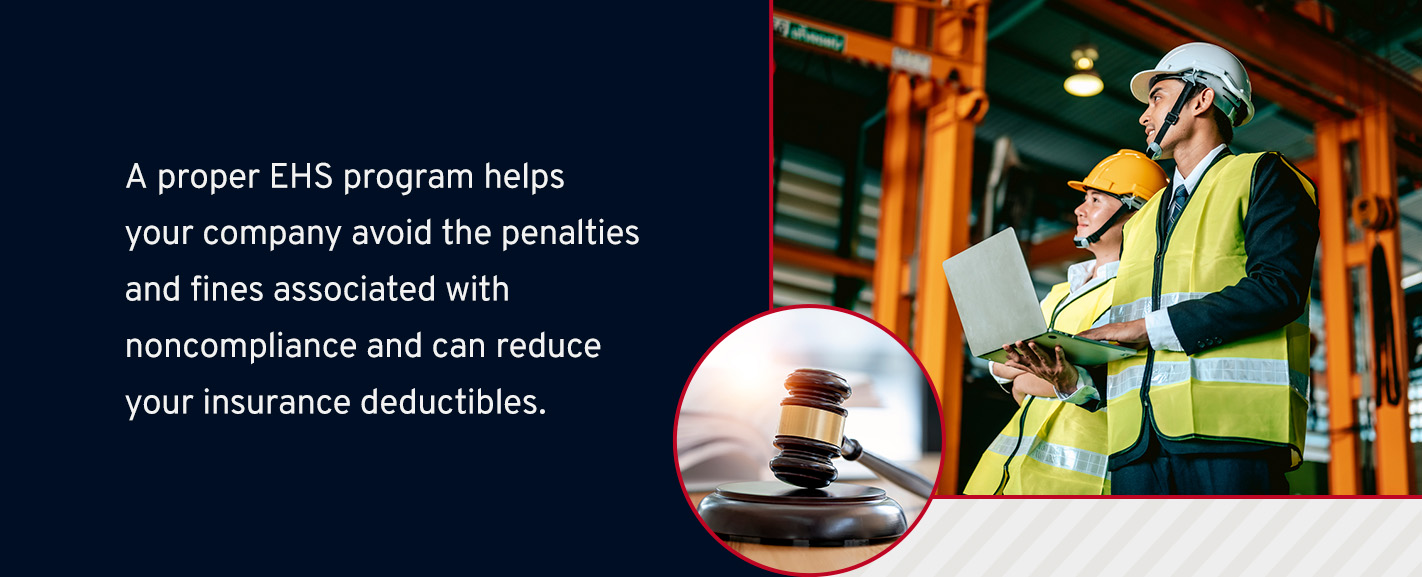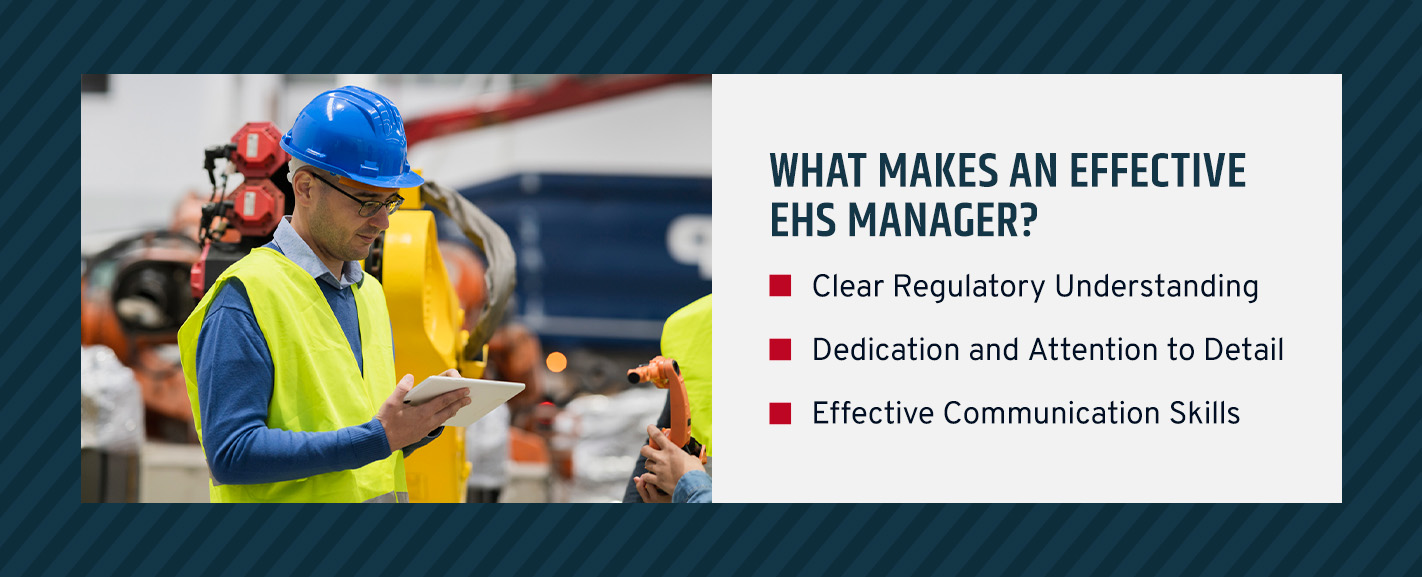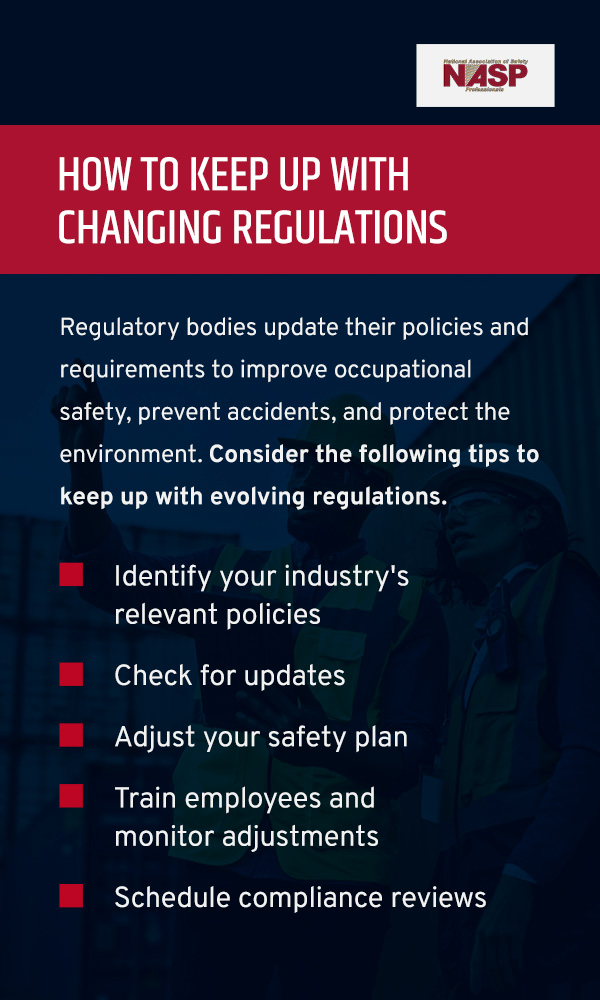
Environment, health, and safety is a framework organizations use to protect employees, surrounding communities, and the environment from potential hazards. EHS managers implement health and safety plans to help companies comply with regulations set by agencies like OSHA.
What Is Environment, Health, and Safety?
EHS is a multidisciplinary field that protects the environment and occupational health and safety. The environmental portion focuses on releases and spills that could harm our shared air and groundwater. The health facet simultaneously targets potentially harmful biological pathogens, airborne particulates, radiation, and noise exposure. Meanwhile, the safety aspect of EHS concentrates on equipment or situational hazards that can cause workplace injuries, such as falls, accidents, or machine collisions.
Importance of Environment, Health, and Safety
EHS is crucial because it prevents harmful incidents, and prioritizing EHS offers the following advantages.
Employee Safety
Every employee should feel safe in their work environment. EHS systems, programs, and managers ensure workspaces are as secure as possible. EHS managers implement specific rules and protocols to prevent accidents and injuries.
Employee Health
EHS systems and managers protect employee health to prevent temporary and permanent illness. Protecting workers from hazards such as airborne particulates, noise exposure, and radiation enables them to work without the risk of hearing loss, lung damage, and chronic diseases.
Environmental Health
The importance of EHS also extends to the environment. A high-quality EHS program reduces a company’s environmental impact and prevents it from causing severe harm. EHS managers and systems protect the shared ecosystem and natural resources in the areas surrounding a business.

Legal Compliance and Cost Savings
A proper EHS program helps your company avoid the penalties and fines associated with noncompliance and can reduce your insurance deductibles. With structured plans and monitoring, your organization can meet legal regulations and avoid repercussions such as civil lawsuits and criminal charges.
Positive Reputation
Meeting requirements and preventing accidents also maintains a positive reputation. When your professional partners and the public population know how well you protect your employees and the environment, they are more likely to continue doing business with you or using your products or services.
Positive Employee Relations
EHS efforts also boost morale and reduce employee turnover. Workers are more likely to stay with a company long-term when their workplace invests in their health and safety. You can save significant time and money on hiring and training efforts by providing a healthy work environment and retaining your current workforce.
Greater Productivity
A safe work environment encourages employees to concentrate on critical tasks and complete work promptly. Prioritizing health and safety prevents injuries and illnesses, boosting your workforce’s productivity.
What Does an EHS Manager Do?
An EHS manager plans, implements, and monitors safety programs within an organization, fulfilling these responsibilities:
- Performing safety audits
- Investigating accidents
- Determining health and safety solutions
- Creating and implementing safety programs
- Enforcing regulations
- Training employees
- Evaluating workplace systems and procedures to ensure OSHA compliance

What Makes an Effective EHS Manager?
A company’s health, safety, and environmental impact is only as successful as its EHS manager. Effective EHS managers embody the following qualities.
Clear Regulatory Understanding
Understanding OSHA and environmental laws and regulations is crucial for successful EHS management. A manager’s EHS plans must meet all regulatory requirements for a company to maintain the safest workplace possible, which necessitates ongoing education. Since government regulatory bodies frequently update laws and regulations, EHS managers must continuously learn and update their knowledge base to ensure compliance.
Dedication and Attention to Detail
EHS management is more than creating plans and addressing risks. It requires close attention to detail so you can ensure each employee follows procedures and rules effectively. As an EHS manager, it’s your responsibility to organize employee training that teaches workers to follow regulations. When employees fully understand how to use equipment and materials safely, they can better support your efforts in preventing hazards.
Effective Communication Skills
Open, transparent communication is another essential aspect of monitoring and maintaining an EHS program. If you are in charge of an organization’s safety rules and procedures, the company depends on you to explain the ins and outs to everyone, including answering questions about a policy.
What Credentials Does an EHS Manager Require?
An EHS manager typically holds the following credentials.
Bachelor’s Degree or Higher
Most EHS managers start their careers by earning a bachelor’s degree in industrial management, business, chemical engineering, occupational safety, or environmental health. Some companies require EHS managers to hold a master’s degree or higher.
Professional Certificates
EHS managers also require specialized certificates that meet or exceed OSHA standards. Ongoing education improves an EHS manager’s credentials and updates their knowledge on the latest compliance updates.
An Overview of Environment, Health, and Safety Regulations
Agencies such as OSHA, the U.S. Department of Transportation, and the Environmental Protection Agency set EHS regulations. While each industry follows specific rules and codes of conduct, you most likely need to pay close attention to the following factors in your EHS plans.
Environmental
EHS managers should be aware of these variables that affect our environment.
- Air quality and emissions: Emissions from vehicles, equipment, and facilities can reduce air quality and contribute to air pollution. The EPA issues and updates regulations to reduce greenhouse gas emissions from vehicles and heavy equipment.
- Wastewater: Your company must comply with wastewater disposal standards to ensure that water from your facility’s operational processes, breakrooms, bathrooms, and kitchen does not harm the environment.
- Water conservation: Some regulations control how much water you consume to conserve resources.
- Energy conservation: Policies exist to prevent your company from wasting energy.
- Waste and hazardous materials management: Properly managing hazardous materials prevents them from harming the land. Specific rules govern the appropriate handling of your company’s hazardous materials and waste.
- Noise: Counties, municipalities, and cities enforce noise limitations to minimize disruptions to their residents. These may require you to enclose noise-producing equipment, install soundproofing materials, or use quieter machines in your facility.
Occupational Health and Safety
Occupational health and safety regulations focus on hazards related to a company’s operation, facility and production.
- Chemical, physical, biological, and radiological hazards: Health and safety standards protect employees from hazards such as chemical burns, equipment collisions, infections, and cancer.
- Special hazard areas: Regulations require designated areas within a facility to contain specialized hazard fire suppression systems to detect and extinguish fires without using water. Data centers and commercial kitchen range hoods are common examples of special hazard environments containing high-value equipment, flammable liquids, or high air flow.
- Personal protective equipment: Personal protective equipment such as respirators, safety glasses, gloves, hearing protection, full body suits, and helmets protect workers from hazards on the job. Facilities must provide their employees with PPE if their tasks might harm their eyes, skin, lungs, or body.
- Facility design and operation: Some regulations require facilities to design facility layouts and features to optimize safety. For example, your company might need to keep equipment in accessible spaces where workers can easily operate and maintain them.
- Training and communication: Employees working with dangerous equipment or materials or in a hazardous area must receive thorough training. EHS managers organize new and ongoing training to comply with specific requirements.
- Environment and operation monitoring: Ongoing monitoring ensures your facility, employees, and operations comply with all rules and standards.
Community Health and Safety
Organizations must consider how their operations and procedures affect the communities around them. The following EHS factors relate to protecting the people and communities who live near a factory, warehouse, or similar facility.
- Water availability and quality: Some policies are in place to prevent a company’s operations from reducing water availability and quality within a community.
- Disease prevention: Toxic pathogens can cause illness if people inhale or ingest them. Laws prevent organizations from releasing harmful gases and materials into surrounding communities through the air or water sources.
- Structural safety: Each facility must meet structural guidelines to ensure safety for workers and community members.
- Life and fire safety: Businesses must have appropriate fire protection systems and train staff to use them.
- Hazardous material transportation: Policies regarding hazardous material transportation prevent toxic gases, liquids, and solids from harming the environment and people in the communities surrounding a business.
- Traffic safety: Companies must train drivers to adhere to strict traffic safety laws. Safe driving protects everyone from accidents and collisions.
- Emergency preparedness and response: Preparing for emergencies is another essential part of compliance. Inspectors often evaluate if companies have the training and resources to keep employees and the community safe in an emergency.

How to Keep up With Changing Regulations
Regulatory bodies update their policies and requirements to improve occupational safety, prevent accidents, and protect the environment. Changes may occur due to new reviews, findings, observations, or reports. For example, multiple reported forklift accidents may cause a government agency to update its forklift operation policy. Consider the following tips to keep up with evolving regulations.
- Identify your industry’s relevant policies: The policies your company must follow depend on your specific industry, and identifying which regulatory bodies you must adhere to is essential.
- Check for updates: Agencies such as EPA, DOT, and OSHA post policy changes on their websites, making it quick and easy to check for new or altered regulations. Plan to check for updates weekly or monthly so you can adjust your internal handbook accordingly.
- Adjust your safety plan: After updating a policy, regulatory agencies like OSHA often give organizations a designated period to make necessary changes and comply with the new requirements. While agencies typically allow a set number of months or years to make changes, swift action is usually necessary to allow enough time for the proper adjustments.
- Train employees and monitor adjustments: Employees focus on their responsibilities and rely on you to update them on safety procedures. When you notice a regulation update, communicate new procedures and policies with all employees so they understand the change and their role in adhering to it.
- Schedule compliance reviews: Compliance reviews identify areas where you need to adjust your safety plan or implement it more effectively. Scheduling a compliance review can improve your company’s results when an auditor visits your facility because it lets you shore up vulnerabilities in your safety plan.
Specialized Training for EHS Managers
Choosing the right EHS training course is essential for meeting OSHA requirements and implementing safe operations. Whether you need a certificate to start your EHS career or want to update your knowledge, you can earn a Professional Certificate in Environmental Health and Safety at your pace. The National Association of Safety Professionals offers the Environmental Health and Safety Professional Certificate Course for those who need to develop and maintain essential knowledge.
The Environmental Health and Safety Professional Certificate Course provides the resources necessary to plan and implement safety protocols. With this course, you can understand each regulatory body’s requirements and how to meet them. Whether you’re a new or experienced EHS manager, the EHS Professional Certificate Course can help you increase your expertise and fulfill your responsibilities effectively.
You may complete the EHS Professional Certificate Course faster if you have knowledge or training in workplace safety, but the curriculum is foundational and requires no prerequisites.
Increase Your EHS Knowledge and Credentials With NASP
EHS is an essential part of a company’s success. As an EHS manager, you have the honor of protecting an organization, its employees, and the surrounding community. Understanding regulations and how to meet them is crucial for this line of work, and NASP prioritizes helping busy professionals improve their knowledge.
With NASP’s EHS Professional Certificate Course, you can complete training at your preferred pace and expand your understanding of essential regulations. Our customer support team is available to answer any questions you have about OSHA regulations while taking the course, giving you valuable advice on protecting employees.
At NASP, we use a dynamic and interactive approach to boost retention so safety is at the forefront of your mind, and our courses take an in-depth approach to workplace safety. Sign up for the EHS Professional Certificate Course, or contact us to learn more about our training programs.






